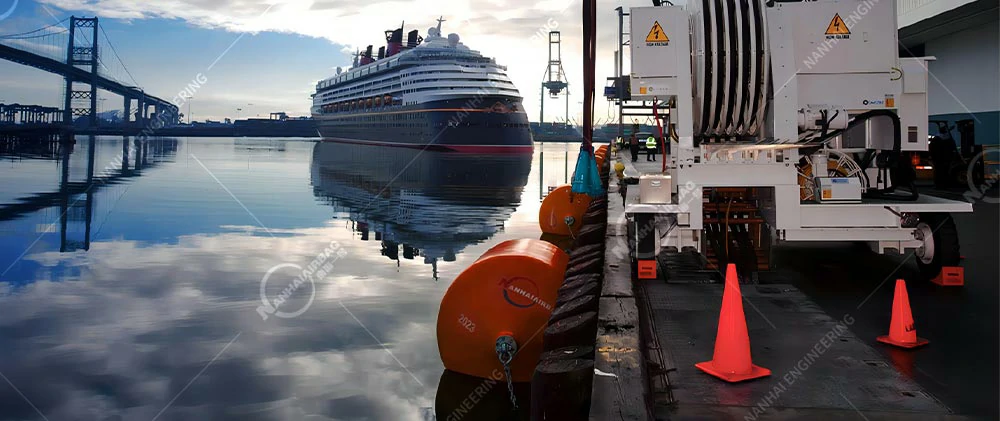Défenses pneumatiques en caoutchouc de haute qualité
09/09/2025Choisir les défenses marines en caoutchouc adéquates
09/11/2025Défenses marines remplies de mousse : Protection fiable des navires et des quais
How do you protect your vessels and docks from heavy impacts during berthing?
Is there a way to reduce maintenance costs while ensuring maximum safety?
Foam filled marine fenders are the answer. These durable, low-maintenance fenders provide excellent energy absorption and long-lasting performance, making them the ideal solution for ports, terminals, offshore facilities, and ship-to-ship operations. In this article, we’ll explain how they work, why they are effective, and where they are most commonly used.

How Foam Filled Marine Fenders Work
Foam filled marine fenders are designed to absorb high levels of impact energy while protecting both the vessel and the dock. Their structure combines two key components:
- Outer Shell – A tough layer of polyurethane or reinforced rubber that resists wear, punctures, and harsh weather.
- Mousse de base – High-density closed-cell foam that compresses under impact and returns to its original shape quickly.
When a vessel comes alongside a dock or another ship, the outer shell spreads the contact force across a wider area, while the foam core absorbs the energy through controlled deformation. Once the pressure is released, the fender regains its shape instantly, ready for the next operation.
Unlike pneumatic fenders, foam filled fenders don’t rely on air pressure, so they are not at risk of deflation. This makes them safer, more reliable, and easier to maintain, especially in demanding marine environments.
Key Features and Advantages
Foam filled marine fenders are trusted worldwide because they combine durability with low operational costs. Their main benefits include:
- Absorption d'énergie élevée – Effectively reduces damage to vessels and dock structures.
- Faible entretien – No inflation or air pressure checks are required.
- Exceptional durability – Resistant to cuts, punctures, UV rays, and saltwater corrosion.
- All-weather performance – Suitable for extreme cold, tropical heat, and rough sea conditions.
- Cost efficiency – Longer service life lowers replacement and repair expenses.
These features make ailes en mousse a reliable long-term investment for ports and ship operators who want to reduce downtime and improve safety.
Typical Applications
Foam filled marine fenders are versatile and can be used in a wide range of maritime environments. Here are some of the most common applications:
1. Ports commerciaux
Large cargo ships and tankers need robust fender systems that can handle high-energy impacts. Foam filled fenders offer consistent performance even under heavy workloads, making them ideal for busy port operations.
2. Passenger Terminals
For passenger ferries and cruise ships, safety and smooth docking are top priorities. Foam filled fenders provide reliable protection while minimizing the risk of vessel or terminal damage, ensuring an uninterrupted passenger experience.
3. Ship-to-Ship (STS) Operations
During offshore refueling or cargo transfer, vessels often berth alongside each other in open water. Foam filled marine fenders offer excellent stability and cushioning, reducing collision risks and ensuring smooth operations.
4. Offshore Platforms
Oil rigs and floating production units operate in harsh marine environments where strong winds and waves create high-impact forces. Foam fenders help safeguard these critical structures and the vessels that service them.
5. Military and Special Vessels
Naval vessels and specialized marine crafts often require maximum protection under challenging conditions. Foam filled fenders meet stringent performance and safety standards, making them the preferred choice in defense operations.
Foire aux questions (FAQ)
Q1: How long do foam filled marine fenders last?
A : With proper installation and routine checks, they typically last between 10 and 20 years, depending on environmental conditions.
Q2: Can they handle extreme temperatures?
A : Yes. High-quality foam filled fenders perform reliably in both freezing conditions and tropical heat.
Q3: Do they require inflation or air pressure checks?
A : No. Unlike pneumatic fenders, foam filled fenders use a solid foam core, so there’s no risk of air leakage or deflation.
Q4: Are they compatible with existing berthing systems?
A : Yes. Foam filled fenders are designed for flexible installation and work with most standard dock and vessel configurations.
